Shivling, the perfect attempt by Daniela Teixeira and Paulo Roxo
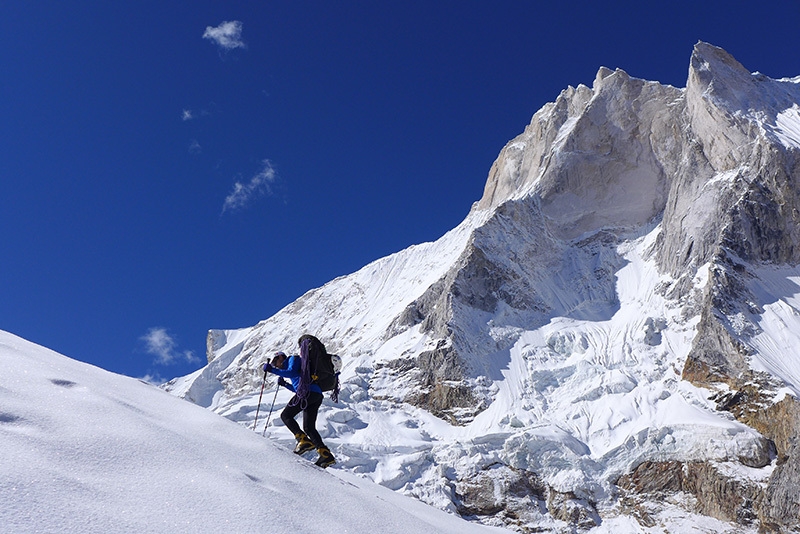
 1 / 15
1 / 15 Daniela Teixeira and Paulo Roxo
Daniela Teixeira and Paulo Roxo
On Shivling, at around 6000m, the point we gave up, we avoided crossing that “fine line”, the boundary of uncontrolled risk, and we`re glad we did it. The snow storm that caught us on the last day on the mountain, still coming down the last technical section, came unpredictably fast. Giving up at the right moment was like a kind of a sign from god Shiva himself. It was the same storm that killed more than 40 people in Nepal.
Acclimatization
On September 28th, we left Tapovan´s Base camp having in mind to recognise the way to the col between Shivling and Meru, and have a closer look at Meru’s unclimbed east spur, our goal for this expedition.
On the day after, we climbed until 5450m and stopped a bit before the col, as a consequence of finding the snow in abominable conditions despite the previous days of good weather. It was so cold that the snow simply didn’t transform at all and we buried ourselves knee deep.
Just on the edge of a giant crevasse that protected us from any rock falling from a close upper wall, we made a decent platform to place our bivy. From there we analysed our chances. The east spur of Meru was glowing in the sun since 6:30 a.m. and a close look revealed snow runnels everywhere. So, quite fast we realized there was only one option for us. We decided to give up on Meru, it was simply too exposed, too dangerous. While returning to base camp, we spotted a nice line on Shivling’s North face, a mountain we never ever thought about climbing.
Shivling’s North face - First attempt
After a couple of days, we headed for Shivling (6543m), to try a new route up its north face, leading to the unclimbed north spur. After walking up a few hundred meters on a loose scree slope, the “official” climb started at about 5000 m, with a pleasant mixed climbing pitch that lead to a beautiful and enjoyable narrow gully, obvious and logical. We decided to baptize it as “Star gully”, as a small tribute to our home’s highest mountain, “Serra da Estrela” (“Star Mountain”). The gully had plenty of small ice sections. The climb wasn’t hard and the granite on both sides as well as the ice sections offered plenty and easy places to protect.
The time went by and we started to worry about finding a spot for the night. We abandoned the gully and climbed to its left in the direction of a prominent spur. Lead by intuition and with some luck, we found a nice bivouac site, at 5500m, just at the top of the spur - the perfect “birds nest” - 10 hours after we left Base camp. We were feeling great and in good shape.
On the next day, we planned to reach the north spur and on the day after go for the summit. In front of us there was a vaguely delineated spur leading to the main ridge. We estimated about 4 to 5 hours for the task ahead. As soon as we started to climb, surprise came in the form of a totally unconsolidated snow covering steep granite slabs. We buried until our crampons scratched those slabs and since on this section the opportunities to place protections were scarce, what from below looked like an easy climb, just became a risky nightmare. We insisted, but were continuously forced to move leftwards trying to find a possible gap between slabs that would allow us to gain some altitude. Finally, after two hours of efforts and only 150m of upward progress we were forced to accept defeat. We were at an altitude of about 5650m. We felt psychologically beaten. We decided to abandon Shivling for good and returned to base camp with all our equipment, leaving absolutely no deposit on the foot of the mountain. Some days later, we reconsidered our chances…
Second attempt - North spur.
Another three days passed and we found the will to give Shivling another try. We would return to our previous new line but this time the plan was to go rightwards just after the first gully (“Star gully”).
At base camp there was a commercial international expedition with some members from Germany. When we told them our idea of trying a new route on Shivling, one of the guys pulled out some paper photos and asked: “Is this what you’re looking at?” To our surprise, there was a line drawn in one of the photos, very similar to the line we imagined. “Damn!” I said. Daniela looked at me in disbelief.
“This last May, some friends of mine came here to try this route.” said the guy, “but finally they climbed another line”. Surprise! The line on the photo was an imaginary one, just a plan, so we had a chance! But soon we discovered the same team found excellent conditions on the mountain and climbed one route just right of our first attempt, then higher up they went slightly more to the right and climbed the centre of the Northwest face. It became obvious that “our line” would share some sections with the new German route. In reality it didn’t really matter to us, as we didn’t have any information about the wall and the mountain presented very different climbing conditions compared to last May. All the surprises and doubts were still there, waiting. For us, it was still true exploration. The adventure mode was in full scale.
The first day (October 11th) went according to the plan, and after climbing “Star gully”, at three o’clock in the afternoon we placed our bivy on a small col, located on the north spur at 5500m.
On the next day we started at 5a.m. with the aim to climb as close as possible to the spur. One of the reasons was to avoid as much as possible being exposed to the menacing serac barrier hanging above. We climbed a bit of everything, rotten snow, hard ice and some easy mixed climbing. The spur didn’t take too much time and three and a half hours later we reached its edge and started to look for a place large enough to fit our bivy. At 5800m, just on the top of an impressive ice chimney falling into the abyss, we managed to build a tiny “kind of” platform in a 15º ramp. We baptized this “sort of” bivy with the name “Cookie camp” because it wasn’t far from the rock rounded bastion we called “Cookie”, as a reference seen clearly from below.
Our third day on the mountain would be our summit day. It was four in the morning when we left the bivy. At first we progressed on good snow with occasional ice sections and we could simul-climb. Protections were sparse but difficulties weren’t still important to care much about it. It was still dark and we headed in the direction of a massive black shadow, the big rock wall that dominates the upper part of the mountain. On the day before, we spotted a little gap that could connect the down icy slopes to the main corridor leading to the bottom of the big serac barrier, and hopefully to the way out on its extreme left. Finally the sun was rising behind the mountains and we started to see something beyond. Fortunately our hunch was correct and we found the gap, in the form of a twenty meters ice climb. For the next 80 meters the climb continued steep and a bit demanding, with some quite technical and interesting pitches that we genuinely enjoyed.
Then, we reached the worst place in the world, as we were directly below the big serac barrier. We would have to do a long, almost horizontal traverse, always below the menacing seracs to regain the north spur. The exposure to that threatening ice wall was massive. From that point our route converged with the one climbed by the German team. Judging by the photos we saw in base camp about this particular section, apparently our predecessors found the snow in very good conditions and have been able to pull this part quickly.
The ice wall above was overwhelming, we felt like sitting ducks with the hunter already pointing at us! We had to be quick. When we started moving again, the ice became harder than expected with a thin layer of snow covering it. At first we had no trouble and the crampons were just doing their job, but soon the problems started. Ice climbing is normally better than slogging in deep unstable snow but, front pointing a huge traverse of 55º black super-hard “concrete” ice, with a backpack on, at 6000m it’s a ridiculously huge effort. This incredible hard ice slowed our pace dramatically, but we felt we could manage it… if we didn’t have the overhanging creeping ice buildings just above our too much fragile heads. Not fun at all! The direction didn’t matter. Up or down we had to run away from that place very quickly. After some minutes of debate we concluded the faster way was… down! Game over!
From that exact point we started the repetitive slow process of abseiling the same route of our attempt. To get down the mountain took us that day, and one extra, the one coincident with the huge storm that killed more than 40 persons in Nepal. Luckily, on Shivling the storm was not that strong. Although we had a whole day of snowy bad weather, we pulled it through and got ok to base camp.
Some technical details
Our attempted route, starts on the right part of the north face of Shivling at 5000m, continues through the north spur from 5500m - on the beginning of the spur it shares common ground with the 2014 German route. After 5800m it climbs the northwest face until meeting the 2014 German route again, at the altitude of 6000m, where we were forced to abandon. It`s about 1000m high, and we found maximum technical difficulties of 55º/WI4/M5.
We abseiled more or less the same line of ascent leaving some mandatory gear like slings on V-threads, pitons, some stoppers and cams.
Paulo Roxo & Daniela Teixeira
02/10/2013 - Kapura South, first ascent in Pakistan's Nangma Valley by Daniela Teixeira and Paulo Roxo
In early September 2013 the Portugese climbers Daniela Teixeira and Paulo Roxo made the first ascent Kapura South (6350m) in the Nangma Valley, Karakoram, Pakistan, via their route Never Ending Dreams (1300m, M4).



 Copia link
Copia link
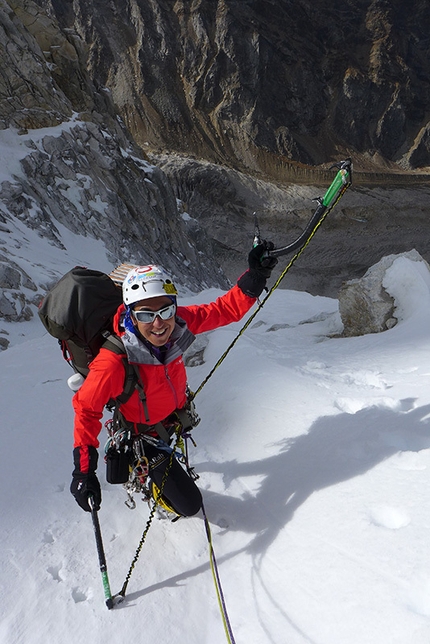
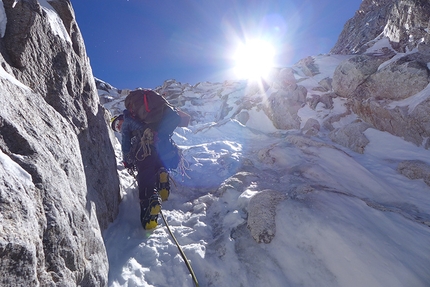
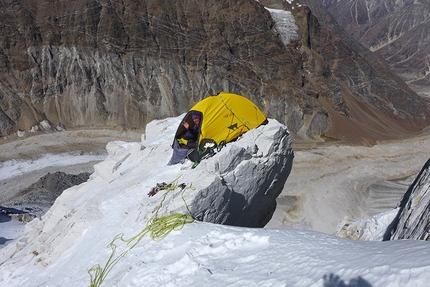
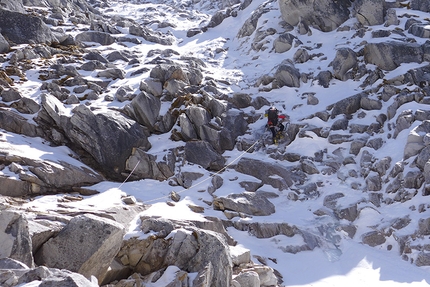
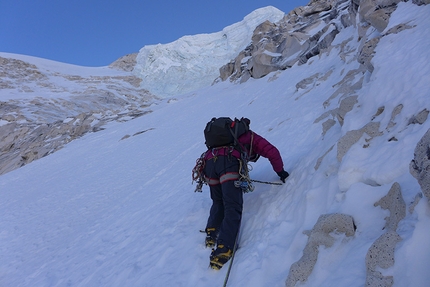
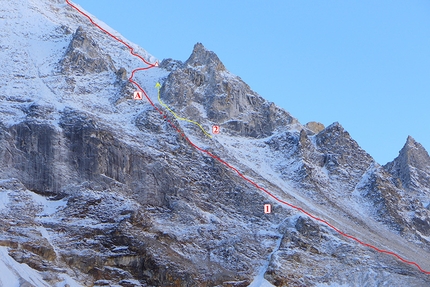
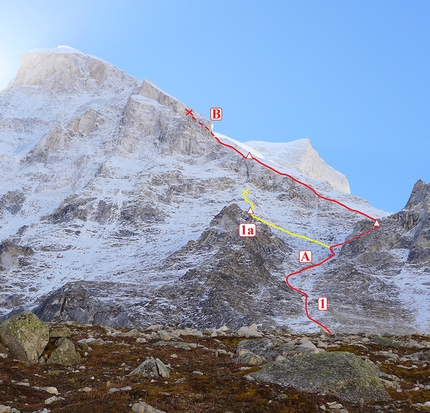
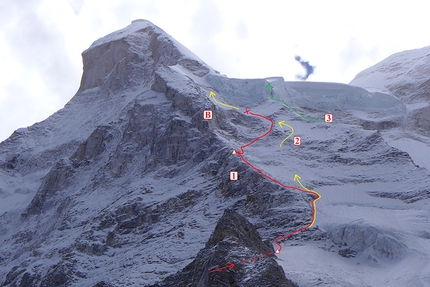
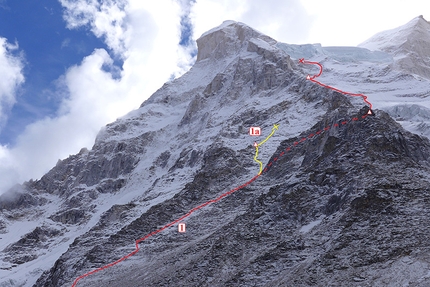
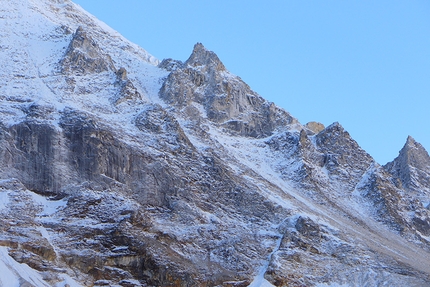
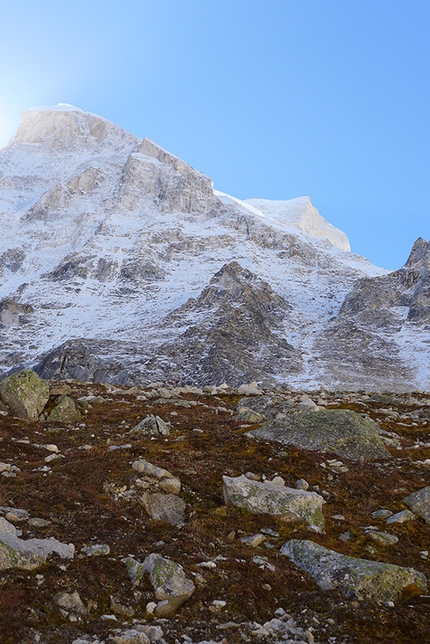
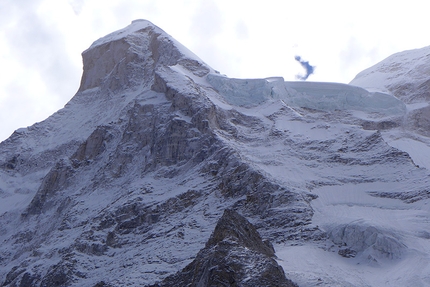
 See all photos
See all photos






















